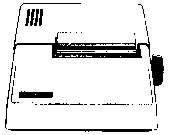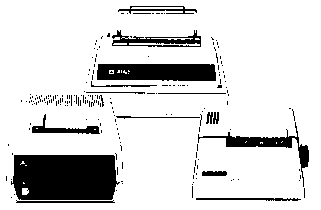roll of paper supplied with the printer, and except for the need of an occasional drop of oil on the print head guide shaft, the 820 performed Flawlessly. The standard 3 7/8 inch roll paper was much easier to find than the ribbon, and is readily available at most office supply or stationary stores. My only complaints during the first month of use was the noise (common with most dot matrix printers) and the automatic timeout cycle, which halts the printing for approximately three seconds to prevent overheating of the printer head. This pause occurs if the printer has been operating for long periods, and if taken into account, this pause changes the actual 40 cps speed of the 820.
I didn't feel as though this test proved the reliability or dependability of the 820, so we decided to use it on something a little more demanding. The mailing labels! Everyone thought that I was a little crazy when I decided to use the 820 for the labels but if this didn't burn the little sucker out, what would? I realize that the 820 wasn't made to be used with labels, but with 31/2 x 16/16 labels and a watchful eye I printed 90% of the labels used on our premiere issue. Surprisingly, it handled the task with very little problem.
Overall, if the noise or speed aren't a determining factor in your choice of printers, and you need a virtually trouble free 40 column printer, than the Atari 820 should fit your needs. The 820 lists for $449.95 and includes all necessary cables and user manual.
THE ATARI 822 THERMAL PRINTER

The first hardcopy device on my 800 was a Trend corn 100 thermal printer on which the ATARI 822 is based. Originally I had it output through a Macrotronics printer interface which includes a small subroutine I added onto Dos 1, so every time I booted up the 810 Disk Drive with DOS 1, the printer driver went in also. The small routine is required to redirect the 'P:' commands through the number 3 & 4 front controller ports rather than the serial port on the 800's right side. This worked fine Until I needed some sort of printout when using Compuserve. DOS 1 won't work with the Telelink I cartridge, so I couldn't use the Macrotronics interface system with the telecommunications setup. So I wired up the Trendcom to the parallel port on the 850 interface module, which needed some coercing to work properly. With help from Trendcom this was quickly solved using a .01 ceramic capacitor on the STROBE line in order to retime the signal (I would get double characters without the retiming: HELLO looked like this on the 100: HHEEELLOO).
When the 822 became available, the top on my 810 disk drive occupied by the Trendcom now became the resting place for the 822. When I first looked inside the 822, 1 thought 'Oh no!, it's missing half the parts, look at all the empty room compared to my Trendcom!'. I don't know how they did it, but the serial driven 822 has much fewer parts than the parallel 100. The printer is so quiet all you hear is the advancement of the paper. The 822 doesn't use ink of any sort, rather its' printing head consists of a heat-producing 'filament' about 3/8 inches square. The special heat sensitive paper darkens to the appearance of blue or black ink depending on which paper you use, and since no ink is used, the lettering won't smudge.The 822 is about the same size as the 410 recorder, and houses the thermal paper role inside the heavily constructed metal and plastic 2.5 inch high casing. Some of the nice features include the ability to see what's being printed almost immediately unlike the 820 ",here the printing takes place deep inside the Unit. The printhead is also bi-directional (it prints left-to-right, and then right-to-left if there are characters on the next line. The appearance of the print quality resembles that of a dotmatrix (like the 820), with a limit of 40 characters per line. The back panel has a 'clean' look to it, with provisions for the standard ATARI power block connector, on/off switch, and two ATARI serial connectors allowing you to daisy-chain your peripherals. When you take all this into consideration, plus the ability of the 822 to print graphics, it becomes the nicest allaround printer for the average home computer owner. The printer won't output the control graphic characters, but will do graphic plotting.
For the $449-95 price, I feel the printer is a prime choice for many users who require smooth, quiet, and reliable hardcopy.
